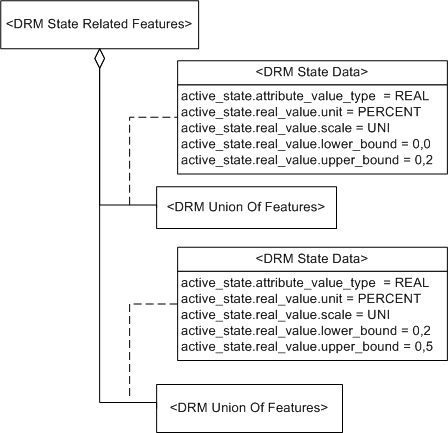Class Name: State Related Features
Subclasses
This DRM class is concrete and has no subclasses.
Definition
An instance of this DRM class specifies a state related organization of
<Feature Hierarchy> components where each
<Feature Hierarchy> component represents a separate
discrete state from a possibly continuous state value. Each discrete
state corresponds to a branch of the
<State Related Features> instance
and is identified by the <State Data> link object
for that branch. The state value itself is specified by the
state_tag
of the <State Related Features>
instance.
Primary Page in DRM Diagram:
Secondary Pages in DRM Diagram:
This class appears on only one page of the DRM class diagram.
Example
Consider a <Feature Model> instance representing a road
in various states of damage due to flooding. The topological connections
of the road differ in each damage state due to bridges being washed away
and various road segments being blocked due to obstructions such as
fallen trees.
Consequently, the <Feature Model> instance has a
<State Related Features> component with
state_tag = EAC_GENERAL_DAMAGE_FRACTION
and active_state_value
= 0.0 % (that is, initially the road is undamaged,
before flooding takes place).
This is depicted in Figure 6.66.

Figure 66 — <DRM State Related Features> damage example
The <State Data> link object for each branch
indicates the range of percent damage for which that
branch describes the feature topology of the road.
If the active_state_value is
controlled dynamically, the
mismatch_behaviour
field of the <State Control Link> instance specifies
what happens if the active_state_value
is greater than 50%.
FAQs
-
Are <State Related Features> instances
the only way to represent multi-state environmental objects in the DRM?
No. <Control Link> instances can be used to
provide a fine level of control
over state by changing fields instead of representing states
as different <Feature Representation>
instances.
Constraints
Associated to (one-way) (inherited)
Associated by (one-way) (inherited)
Composed of (two-way) (inherited)
Composed of (two-way)
Composed of (two-way metadata) (inherited)
Component of (two-way) (inherited)
Notes
Associated to Notes
An association between two
<Feature Representation> instances
indicates that the environmental object(s) that they
represent have the semantic relationship indicated by
the <Base Association Data>
link object on the association relationship.
An association between a
<Geometry Hierarchy> instance and a
<Feature Representation> instance
indicates that the environmental object(s) that they
represent have the semantic relationship indicated by
the <Base Association Data>
link object on the association relationship.
An association between a
<Property Grid> instance and a
<Feature Representation> instance
indicates that the environmental object(s) represented by the
<Feature Representation> instance
and the <Property Grid> instance
(or some specific cell data within that
<Property Grid> instance) have the
semantic relationship indicated by the
<Base Association Data> link object
on the association relationship. Each associated
<Property Grid> instance indicates
whether the entire <Property Grid>
instance or only some specific cell data within it is participating
in the relationship in question.
Associated from Notes
An association between two
<Feature Representation> instances
indicates that the environmental object(s) that they
represent have the semantic relationship indicated by
the <Base Association Data>
link object on the association relationship.
An association between a
<Geometry Hierarchy> instance and a
<Feature Representation> instance
indicates that the environmental object(s) that they
represent have the semantic relationship indicated by
the <Base Association Data>
link object on the association relationship.
An association between a
<Property Grid> instance and a
<Feature Representation> instance
indicates that the environmental object(s) represented by the
<Feature Representation> instance
and the <Property Grid> instance
(or some specific cell data within that
<Property Grid> instance) have the
semantic relationship indicated by the
<Base Association Data> link object
on the association relationship. Each associated
<Property Grid> instance indicates
whether the entire <Property Grid>
instance or only some specific cell data within it is participating
in the relationship in question.
Composed of Notes
The <Image Mapping Function> components
support texture mapping information
for geometry that is to be derived from the
<Aggregate Feature> instance
by the consumer.
These <Image Mapping Function>
instances shall use <Image Anchor>
components to specify the mapping.
A <Presentation Domain> component is needed for
<Aggregate Feature> instances that are
significant only for a particular domain, such as radar.
Fields Notes
If the value of the
unique_descendants
field is SE_TRUE, each
descendant shall be unique in the sense that it shall
appear in only one branch of this aggregation.
Each descendant is a <Feature Representation> instance
within the component tree rooted at the
<Aggregate Feature> instance.
If unique_descendants
is SE_FALSE, at least one
<Feature Representation> instance
appears in more than one branch of the aggregation.
If the value of the
strict_organizing_principle
field is SE_TRUE, each
branch of this aggregation
strictly complies with the organizing principle for its
particular subclass. If this value is
SE_FALSE, at least
one branch does not strictly comply with the given
organizing principle. See the organizing principle constraint
for each specific subclass for details.
The state_tag field
specifies the state by which the
<Feature Hierarchy> components
are being differentiated and shall specify an EAC that qualifies
as state applicable.
The active_state_value field
specifies the default state. If the
<State Related Features>
instance has a
<State Control Link> component, the value of the
active_state_value field
is obtained from that
<State Control Link> instance.
Prev: State Data.
Next: State Related Geometry.
Up:Index.
